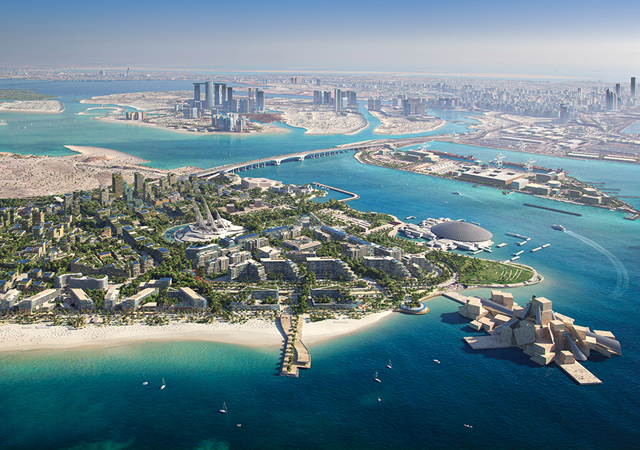
Saadiyat Cultural District has one of the greatest concentrations of cultural institutions in the world.
Cultural powerhouse
01 August 2024
A series of architectural and artistic marvels is nearing completion on Saadiyat Island, Abu Dhabi’s visionary tourism-cultural development, which is rapidly transforming into a global hub for art, heritage, and innovation. With construction on these museums now well beyond the 76 per cent mark (achieved in May), the Saadiyat Cultural District is well poised to unveil their full splendour to the world next year. When they open their doors to the public, this extraordinary destination promises to redefine cultural experiences, offering a captivating blend of iconic museums, immersive art installations, and world-class performances.
Saadiyat Cultural District has one of the greatest concentrations of cultural institutions in the world, showcasing museums, collections, and narratives that support the region’s heritage while promoting a diverse global cultural landscape. It already boasts the Louvre Abu Dhabi, the first universal museum in the Arab world which opened in 2017; Berklee Abu Dhabi, which offers a vibrant space for music, performing arts, and educational programmes; Manarat Al Saadiyat, which serves as a hub for creative expression, hosting key events like Abu Dhabi Art and Culture Summit Abu Dhabi; and Abrahamic Family House, an interfaith complex for learning, dialogue, and worship, which opened last year.
The upcoming museums – each of which will be hosted in awe-inspiring and architecturally-striking edifices – include the Zayed National Museum, the UAE’s national museum, which will pay tribute to the nation’s rich history and the legacy of its founding father, Sheikh Zayed bin Sultan Al Nahyan; the Natural History Museum Abu Dhabi, which will take visitors on a captivating journey through the history of our planet and universe; Guggenheim Abu Dhabi, which will focus on art from the 1960s to the present, showcasing significant contemporary artistic achievements; and teamLab Phenomena Abu Dhabi, which promises an immersive and ever-evolving artistic experience.
“Each cultural institution has its own architectural concept/design narrative, which is relative to its content, context and functionality,” a spokesperson for the Department of Culture and Tourism – Abu Dhabi (DCT – Abu Dhabi), which is spearheading these projects, tells Gulf Construction’s Bina Goveas. “The masterplan provides a beautifully organised setting for these cultural institutions by arranging them in key coastal locations on the periphery of Saadiyat Island. Each museum engages with the water’s edge in a unique manner and collectively are poetically viewed as a ‘string of architectural pearls’ nestled between the water and the landmass.
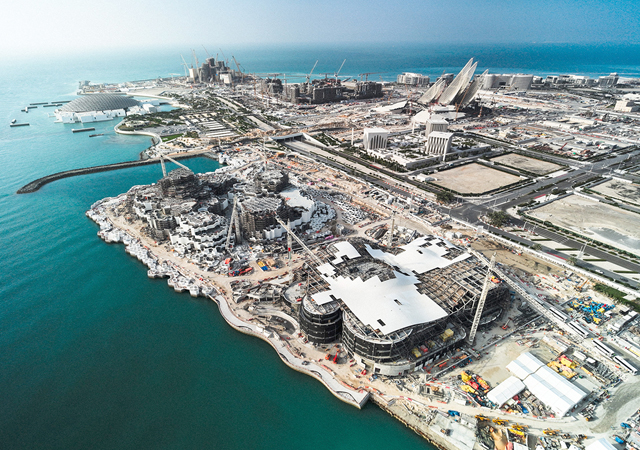 |
|
Construction work on the various museums at Saadiyat is nearing completion. |
“Zayed National Museum is the centrepiece of this architectural ensemble whilst also acting as a linear spinal connection between the water’s edge and the hinterland plots of the district, which contain residential, retail and commercial developments,” the spokesman says.
Elaborating on the materials used in the construction of the buildings’ façade and for the interior finishes, he says: “Each of the museums has its own rich architectural narrative in relation to its content and each building has a different and unique palette of materials, which complements the context and concept.
“The selection of these materials has always had to consider the harsh marine context in which these buildings are located. This has affected the selection of the grade of the metalwork, timber density, durability and the thermal performance of the enclosures etc. There has also been a conscious effort to resource local materials for sustainability and contextuality.”
There’s no doubt that given the scale and the complexities of the projects, design and construction of these landmark structures have presented a number of challenges, which all the key players have put their heads together and tackled with the use of innovative technology.
The spokesman explains: “Each building presents its own unique challenges. Contemporary design software greatly assists in realising these complex forms and simplifying their load paths and compositions into structures that can be realised yet remain as inspiring as the intent. Numerous mock-ups are made during the design and delivery phases to test the visual impact, proof of concept and performance of each assembly. This enables the design team and all key stakeholders to test, comment and enhance the building design whilst also retaining the design integrity, delivery date and project budget intact.”
The Zayed National Museum and Guggenheim Abu Dhabi boast a unique architectural narrative that pays homage to the region’s heritage while pushing the boundaries of design. Construction work on both these iconic landmarks is being undertaken by a joint venture of Six Construct and Trojan General Contracting under the supervision of Abu Dhabi’s Department of Culture and Tourism.
Zayed National Museum
The 72,441-sq-m Zayed National Museum is set to become the centrepiece of the Saadiyat Cultural District. The museum’s location and architectural form are conceived to tell the story of the nation, integrating cultural narratives with natural elements, which is central to Emirati identity.
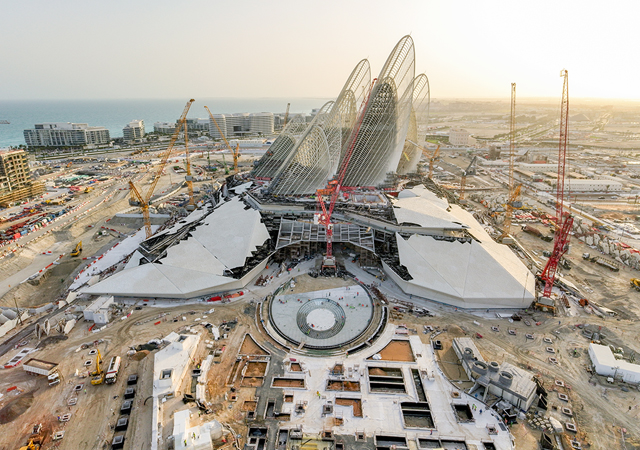 |
|
Work is well advanced on Zayed National Museum. |
Designed by Pritzker Prize-winning architect Foster + Partners, the museum honours the legacy of Sheikh Zayed bin Sultan Al Nahyan (1918-2004), the UAE’s founder and first President.
Rising above the main building is a series of five steel structures that soar over the horizon, resembling the wings of a falcon – a national symbol of the UAE. These “falcon wings” are not just symbolic, representing the nation’s strength and heritage – they serve a crucial function. They act as solar thermal towers, drawing hot air upwards through the museum galleries via the “stack effect”. This natural ventilation system reduces reliance on energy-intensive air-conditioning, aligning with the UAE’s sustainability goals. Inspired by traditional barjeel wind towers, the design utilises natural thermal updrafts to cool the museum interiors, enhancing visitor comfort by providing a cooler and more pleasant indoor environment through passive cooling techniques.
The museum’s landscape has been designed to engage with the topaz water of the Arabian Gulf through a ‘Timeline Garden’, which serves to narrate the natural and manmade landscapes of the UAE from a coastal desert context to an oasis and concluding with a reflection of modern urbanity at the threshold of the museum entrance, according to DCT - Abu Dhabi.
The project utilises advanced design software to ensure the complex forms translate into structurally sound and visually impactful elements. Mock-ups have been instrumental in testing the effectiveness of the falcon wing design for both ventilation and aesthetics.
Zayed National Museum will be the primary institution in the UAE to display material related to the life and achievements of Sheikh Zayed and will include a garden and gallery dedicated to exploring his achievements, his role in unifying the UAE, and the origins and lasting influence of his values on the country.
The museum will explore over 300,000 years of human history, landscapes, languages, and culture of the UAE from pre-history to the present. It will hold in trust a collection of more than 2,500 art and artefacts from the ancient and living cultures of the UAE and the wider region – Southern Mediterranean, North Africa, Europe, India and China – contextualising the interactions, exchanges and influences that each has exerted on the other throughout history.
Guggenheim Abu Dhabi
Across the water, the Guggenheim Abu Dhabi, designed by Pritzker Prize-winning architect Frank Gehry, presents a starkly different architectural language. Gehry, the architect behind iconic structures like the Guggenheim Bilbao, has brought his signature sculptural style to Saadiyat Island.
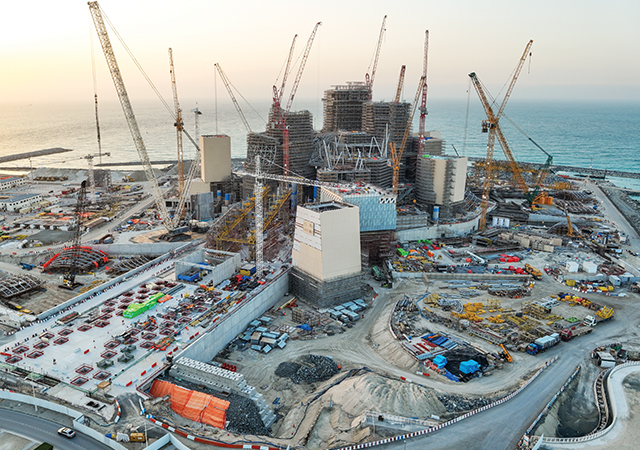 |
|
Guggenheim Abu Dhabi ... construction work is being carried out by a joint venture of Six Construct and Trojan General Contracting. |
The Guggenheim Abu Dhabi takes inspiration from the region’s maritime heritage, featuring a curvilinear design reminiscent of the sails of traditional dhows. Unlike Gehry’s signature metallic finishes often used elsewhere, the Guggenheim Abu Dhabi’s facade is crafted with materials and textures that resonate with the local environment, ensuring a harmonious visual connection to its surroundings.
The design of the museum emphasises connectivity and openness, with spaces that encourage social interaction and cultural exchange, reflecting the communal values of the UAE. Architectural elements such as the museum’s layout, gallery spaces, and public areas are designed to foster dialogue between different cultures and art forms, aligning with Abu Dhabi’s mission to be a meeting point for global creativity and cultural fusion.
The use of cutting-edge architectural techniques ensures that the building is a testament to modern design while still respecting and reflecting the rich cultural heritage of the region.
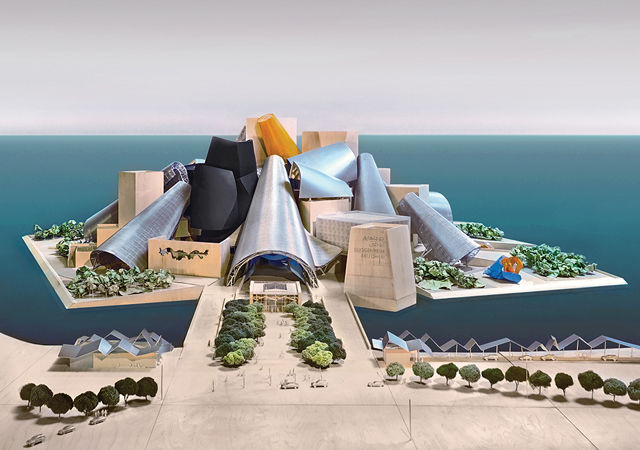 |
|
Frank Gehry’s rendering of the museum. |
Guggenheim Abu Dhabi utilises in abstract, the conical forms of traditional watchtowers as elements which create external shading structures to the entranceways, inspired by the region’s use of passive environmental design technologies such as wind towers. The building also encapsulates its coastal desert context by reflecting the unique colour of the Saadiyat Island sand in its glassfibre-reinforced concrete cladding panels which are configured in Gehry Partners’ signature patterned bond.
With a gross floor area of 80,000 sq m, the Guggenheim Abu Dhabi will be the largest among the Guggenheim museums. The contemporary art museum, which aspires to connect cultures and inspire people by celebrating art from the 1960s to the present, is a collaboration between the DCT – Abu Dhabi and the Solomon R Guggenheim Foundation. Presenting an international collection with a specific focus on West Asia and the wider region, Guggenheim Abu Dhabi fosters a deeper understanding of how different art perspectives have shaped the interconnected cultures and histories of our time.
The museum comprises 28 galleries spanning a total of 12,080 sq m, alongside an additional 23,000 sq m of exhibition spaces in the atrium, external cone plazas, terraces, and landmass encircling the building.
Natural History Museum Abu Dhabi
Designed by Dutch architecture firm Mecanoo, the Natural History Museum Abu Dhabi takes inspiration from the UAE’s geological history. The museum’s exterior features a cluster of buildings resembling natural rock formations, creating an immersive environment that visually and contextually aligns with the exhibits of Earth’s natural history. It reflects the natural sabkha salt flat terraforms of the UAE with a three-dimensional Voronoi-shaped cluster of buildings that are mediated by a green open area that reflects the wadis. The “rock-like” structures minimise the visual impact on the landscape and enhance the building’s thermal performance, reducing reliance on artificial cooling.
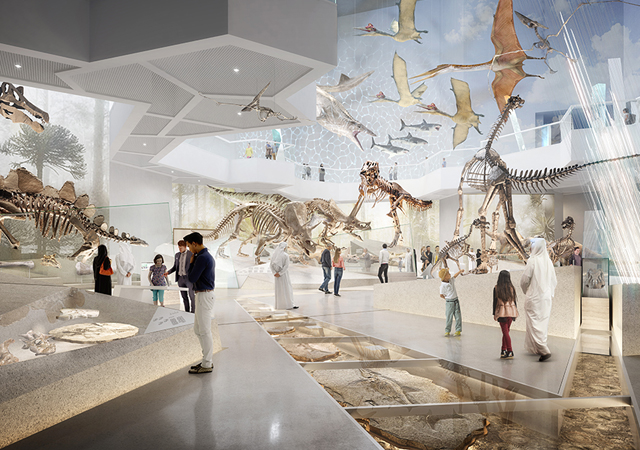 |
|
Natural History Museum Abu Dhabi ... highlights of its collection include a 67-million-year-old fossilised Tyrannosaurus Rex skeleton. |
The Natural History Museum Abu Dhabi has recently been topped out. Work is in progress on the installation of mechanical, electrical, and plumbing (MEP), building fit-outs, and exhibition works for the 35,000-sq-m museum, which is set to be the largest of its kind in the region.
The project is being developed by DCT – Abu Dhabi in conjunction with Miral, Abu Dhabi’s leading creator of immersive destinations and experiences.
Local materials and construction methods are being used to reduce the museum’s carbon footprint. Additionally, the design incorporates water conservation systems and energy-efficient solutions, that minimise its ecological impact and operational costs.
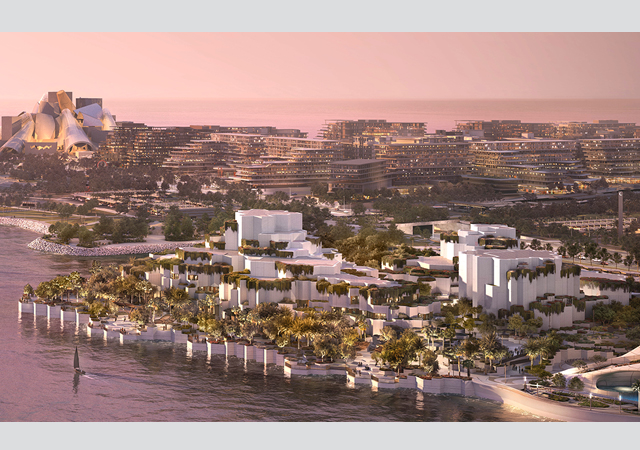 |
|
Natural History Museum Abu Dhabi |
The museum will take visitors on a 13.8-billion-year journey through time and space that will include a thought-provoking perspective on what a sustainable future might look like. Highlights of the museum’s collection include ‘Stan’, a 67-million-year-old, 11.7-m-long, fossilised Tyrannosaurus Rex skeleton and a specimen from the seven-billion-year-old Murchison Meteorite, which contains organic ‘stardust’ compounds older than our solar system.
Visitors will see seven-million-year-old fossils, discovered in Abu Dhabi’s Al Dhafra region, which date from a time when the emirate and much of Arabia was a rich landscape of rivers, savanna grasslands and forests.
A gallery focusing on space exploration features Voyager Interstellar recordings created by Carl Sagan and Ann Druyan and commissioned by Nasa, the Sputnik Activation Key and Logbook, created by the Soviet Union Space Agency and an ISS Space suit, created by Nasa.
teamLab Phenomena Abu Dhabi
An organic space where art and architecture combine with cutting-edge technology and science, the 17,000-sq-m teamLab Phenomena Abu Dhabi will take visitors on an immersive, multi-sensory journey through 17 digital art experiences in which they encounter artworks that change in response to their environment.
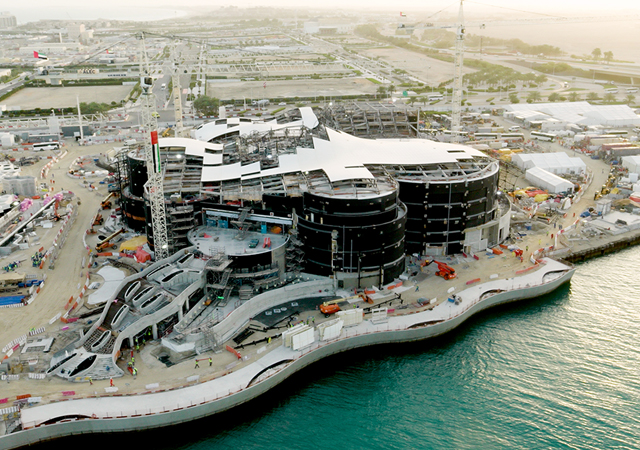 |
|
Construction work in progress at teamLab Phenomena Abu Dhabi. |
The architecture of teamLab Phenomena Abu Dhabi, which was conceptualised and designed by teamLab Architects and realised by Abu Dhabi-based MZ Architects, will play an important role in providing the artworks with an environment to evolve freely and organically. The museum has been designed to inspire ‘infinite curiosity’, trigger the senses, spark imagination and awaken a thirst for knowledge.
The design of teamLab Phenomena Abu Dhabi, intended to be an organic integration of art and architecture, offers visitors an immersive experience where the physical space and the digital artworks interact seamlessly. This integration allows the artwork to extend beyond traditional boundaries, with installations that respond to and are altered by the visitors’ movements. This dynamic interaction fosters a unique and personal experience for each visitor, reflecting teamLab’s philosophy that art evolves and changes continuously.
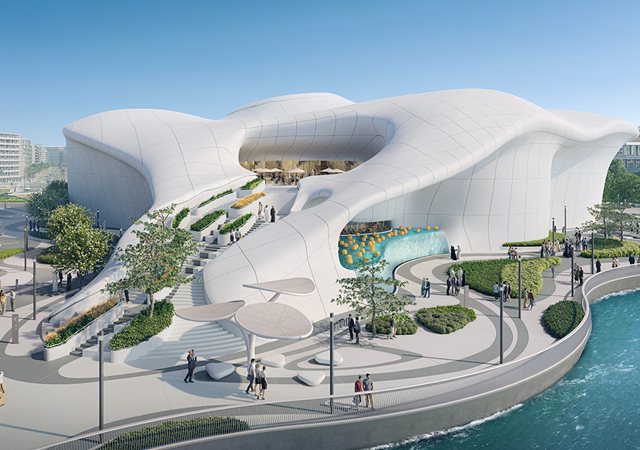 |
|
A rendering of the museum. |
Integrating advanced technology with architecture presents technical and maintenance complexities, requiring specialised skills for installation and long-term care. The design also takes into account rapid technological advancements, ensuring that the infrastructure can adapt to future innovations without extensive overhauls.
Unlike a traditional museum with a container-like structure housing exhibits, teamLab Phenomena itself becomes the canvas for the art. The architecture wraps around the experience, providing a dynamic environment for the ever-evolving digital artworks.
Established in 2001, teamLab is a Tokyo-based, international art collective that is committed to exploring the confluence of art, science, technology, and the natural world.
- Building sustainably
- Cultural powerhouse
- Sustainable City-Yas Island gets top design ratings
- Abu Dhabi projects at a glance


